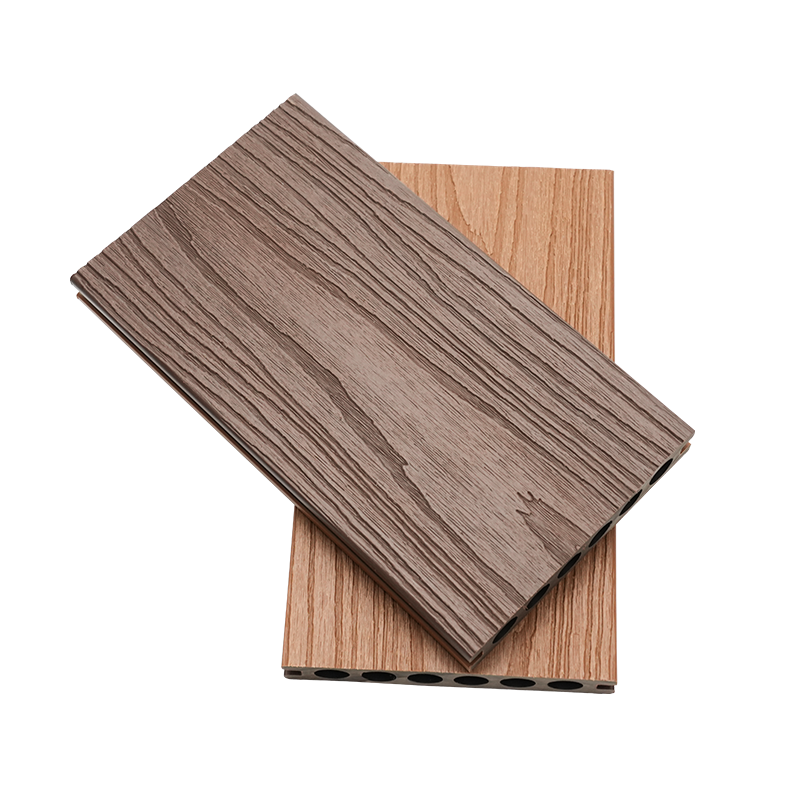If you need any help, please feel free to contact us
WPC composite decking boards have rapidly gained popularity in both residential and commercial outdoor projects due to their durability, low maintenan...
READ MORE



The second generation of wood plastic board is also made of wood powder and plastic. A protective film is added to the surface, which is more durable and waterproof. It can effectively resist ultraviolet rays. It contains special additives that can effectively resist erosion by fungi, bacteria, borers, etc., and has a longer service life. It is both economical and environmentally friendly, non-toxic and harmless, and will not produce harmful gases and pollutants. The second generation of wood plastic board has a better texture, and the color and pattern can be adjusted according to different needs.
The second generation of embossed co-extruded flooring has multiple functions, mainly including improving aesthetics, enhancing durability, improving installation and maintenance convenience, and providing an environmentally friendly and healthy use environment. The second generation of embossed co-extruded flooring is closer to solid wood flooring in appearance and texture. It has a real wood grain effect and can simulate the texture of various woods, giving people a natural and elegant feeling. This real wood grain effect not only improves the beauty of the floor, but also increases its natural beauty. The second generation of embossed co-extruded flooring has also been significantly improved in durability. Its surface layer uses a special wear-resistant material with excellent wear resistance and scratch resistance. It can resist wear and scratches in daily household use and keep the floor beautiful for a long time.

WPC composite decking boards have rapidly gained popularity in both residential and commercial outdoor projects due to their durability, low maintenan...
READ MOREIn the evolving landscape of outdoor construction materials, homeowners, landscapers, and architects are increasingly exploring alternatives to tradit...
READ MOREIntroduction As outdoor living spaces continue to evolve, WPC composite decking boards have become one of the most favored materials for patios, balco...
READ MOREIntroduction Outdoor decking materials face constant challenges from moisture, UV radiation, temperature fluctuations, and biological decay. Over time...
READ MOREIn the evolving landscape of architectural materials, modern exterior siding panels have become a focal point for builders seeking both performance an...
READ MOREWood Plastic Composite (WPC) has reshaped the outdoor living market by offering an alternative to traditional timber. The first generation of composite boards combined wood fibers with polymer resins, giving homeowners a durable, low-maintenance choice. However, 2ND Generation WPC Composite Decking pushes this innovation further. Produced through advanced co-extrusion, it features a high-performance protective shell that surrounds the core. This shell significantly enhances resistance against weathering, staining, fading, and heavy wear, ensuring the material maintains its strength and beauty even in harsh conditions.
The difference lies in engineering sophistication. Early products often suffered from scratches, fading, and moisture penetration over time. By contrast, this second-generation decking incorporates:
These advancements not only extend product lifespan but also provide greater reliability, which is especially important for large-scale commercial projects where durability and consistency are critical.
Sustainability has become central in construction and landscaping, and this new generation of decking directly addresses these concerns. By combining recycled plastics with reclaimed wood fibers, manufacturers reduce landfill waste and lessen dependence on virgin materials. Unlike timber decking, which requires ongoing sealing, staining, and eventual replacement, these upgraded boards last longer with minimal upkeep.
Over a 20-year period, traditional timber may need multiple treatments and partial replacements, while this second-generation composite continues performing with only simple cleaning. This reduced lifecycle impact makes it an environmentally responsible choice for homeowners, developers, and municipalities alike.
The list of practical advantages is extensive:
Applications are broad: from residential patios and rooftop terraces to resort walkways, marina docks, and community parks. Because it balances beauty with durability, this decking fits both private and high-traffic public environments.
Architects and designers increasingly seek materials that merge nature-inspired aesthetics with engineered strength. The surface of these advanced panels can replicate oak, cedar, or tropical hardwood grains while maintaining consistent color across every board. Homeowners benefit from design flexibility: modern gray tones for minimalist projects, warm brown shades for rustic charm, or bold dark finishes for contemporary luxury.
Importantly, the boards retain their beauty without constant care. This allows outdoor spaces to remain visually appealing year after year, which is highly valued in hotels, restaurants, and premium residential projects.
While the upfront cost is higher than natural wood, the overall value quickly becomes clear. Consider this comparison:
For homeowners, this means more free time and less expense. For developers and commercial property managers, it translates into predictable budgets and reduced operational headaches.
Beyond technical performance, user experience is a key factor. Families appreciate the comfort of splinter-free, barefoot-friendly boards. Pet owners value the scratch resistance. Outdoor entertainers enjoy knowing spills—from wine to barbecue sauces—can be cleaned with little effort. These lifestyle benefits help explain why more households and businesses are choosing composites over traditional timber.
The decking industry continues to evolve rapidly. Researchers are exploring:
Globally, demand is rising as more regions adopt sustainable construction standards. Urbanization, combined with consumer preference for low-maintenance lifestyles, ensures continued growth of second-generation composites in residential, commercial, and public sectors.
Jiangsu Xuanhui New Material Technology Co., Ltd. exemplifies this progress. By investing in co-extrusion technology and advanced additives, the company produces boards that balance durability with refined aesthetics. Their focus on eco-friendly practices and consistent quality reflects the broader industry trend of merging material science with sustainability.
The future of outdoor living spaces depends on materials that balance durability, environmental responsibility, and design flexibility. 2ND Generation WPC Composite Decking achieves this balance, offering weather resistance, sustainability, and long-term economic value. By meeting both practical and aesthetic demands, it is positioned to become the global standard for outdoor flooring, shaping the next era of patios, terraces, and landscaped environments worldwide.